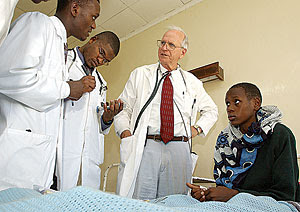Dr. Joe Mamlin consults with medical staff and a patient at the Moi Hospital in Eldoret, Kenya. Photo: Karl Grobl
The initial partnership agreement has led to a host of programs that have impacted hundreds of thousands of Kenyans and the Americans who come into contact with them. In 1990 three medical students and a handful of residents participated in the partnership program’s exchange. Since then, more than 800 have participated, says Einterz, associate dean for international programs at the IU School of Medicine and the Indianapolis-based director of the IU-Kenya partnership.
Several other universities have joined the IU-Kenya partnership, both independently and through the ASANTE Consortium (America/sub-Saharan Africa Network for Training and Education in Medicine). Other partners include Brown University, University of Utah, Duke University, University of Toronto, and the resident training programs in Portland-Providence, Ore., and Lehigh Valley, Penn.
“It has grown quite a bit over the past 15 years,” says Einterz, who served as the program’s first physician-in-residence. “We have invited other universities to join with us in Kenya in large part because we envision a rich network of medical schools linking with counterparts in Africa. We love to see other U.S. medical schools developing partnerships with Moi University.”
Then there’s AMPATH (Academic Model for the Prevention and Treatment of HIV/AIDS), the rural AIDS program inspired by Daniel Ochieng’s recovery that IU started as an extension of the initial partnership agreement. Its three vital components are care programs that foster HIV treatment and prevention, research programs that enable development of “best-practices” strategies for prevention and treatment, and education programs for health professionals and outreach workers.
AMPATH treats more than 33,000 people each year and feeds more than 30,000, adding about 2,000 new patients per month. It is the largest and most comprehensive HIV-control system in all of Africa. Through its extension programs, AMPATH has created pediatric facilities for children, done HIV-prevention outreach, fostered agricultural training and created factories to further sustainable living options, and built shelters for women and children with AIDS.
Ochieng himself is actively involved with AMPATH, running the patient-adherence outreach program and happily married to another former patient treated for AIDS at the clinic.
Government funding for AMPATH came in the form of an emergency AIDS-relief program known as PEPFAR, the President’s Emergency Plan for AIDS Relief, a U.S.-sponsored grant for large populations. The program has been sustained by numerous other grants, foundations, and individual donations. Today it has expanded to 18 sites, extending from Kenya’s Rift Valley to the Uganda border, and is on track to treat 50,000 people a year by the end of 2007.
Citing the widespread influence of AMPATH and Mamlin’s role in the program, two Hoosier professors, Scott Pegg of IUPUI and David Mason, PhD’78, of Butler University, have nominated AMPATH for the 2007 Nobel Peace Prize. The professors suggested in their letter to the Norwegian Nobel Committee that it would be “perfectly fitting to recognize [Mamlin] as a co-recipient of the peace prize.”
Challenges unique to the African medical system have inspired innovative treatment solutions. In America, says Mamlin, a doctor writes prescriptions and sends patients on their way.
“Forget that in Africa,” he says. Treating HIV among the poor people of western Kenya, Mamlin says, “extends beyond offering drugs to reconstitute the damaged immune system to offering solutions that reconstitute people’s lives.
“You have to care about the food of their children. And find a way to pay the rent if they have any hope of going back to work. And create an infrastructure so they can heal themselves. The list goes on and on.”
AMPATH has its own farms with support from the World Food Programme, a United Nations agency, headed until April by former IU trustee Jim Morris, BA’65, that supports economic and social development. Mamlin says the program’s distribution system “would be the envy of Wal-Mart.” Its food program is the first in the world to offer full food support along with HIV care — for the patient’s entire family.
“You can’t just feed the patient,” says Mamlin. “Can you imagine having an impoverished mama with HIV who has no food, and you give her food and say, ‘This is for you, not your children’? We feed everyone in the house so that everyone comes up together.”
AMPATH’s services extend beyond treatment to prevention. The program will screen 30,000 pregnant women for HIV this year, cutting the transmission rate of the virus from 50 percent to less than 5 percent. Programs are also being developed around each of AMPATH’s health centers, which offer orphans a place to sleep, clothing, and food, as well as a chance to continue their education and acclimate themselves into society.
“Otherwise, it’s going to be another wave of disaster — this large number of young people growing up who never had any boundaries or training or schooling,” says Mamlin.

No comments:
Post a Comment